Biophilic Experience in High-Rise Residential Areas in China: Factor Structure and Validity of a Scale
Abstract
1. Introduction
2. Materials and Study Design
2.1. Study Design and Methodology
2.2. Data Collection
2.2.1. Investigation Sample
2.2.2. Semi-Structured Interview
2.2.3. Questionnaire Survey
2.3. Data Analysis
3. Results
3.1. Interview Analysis
3.2. Exploratory Factor Analysis
3.3. Confirmatory Factor Analysis
3.4. Analysis of Criterion Validity
3.5. Descriptive Statistical Analysis of Items
4. Discussion
5. Limitations and Further Research
6. Conclusions
Author Contributions
Funding
Informed Consent Statement
Data Availability Statement
Acknowledgments
Conflicts of Interest
Appendix A
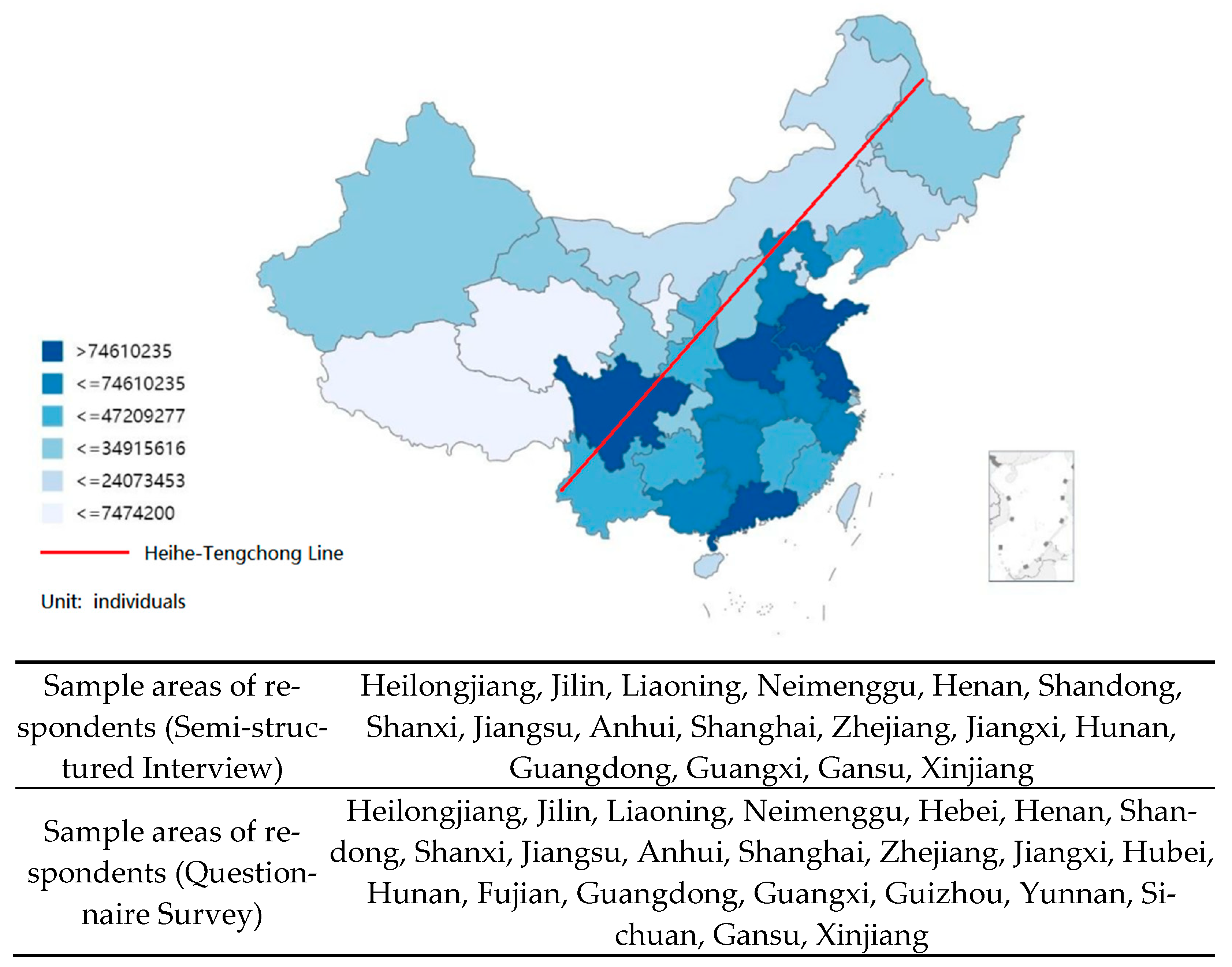
Appendix B
| Measure | Items | Frequency (n = 20) |
|---|---|---|
| Gender | Male | 9 |
| Female | 11 | |
| Age | 18~40 | 9 |
| 41~60 | 6 | |
| >60 | 5 |
References
- Ulrich, R.S. View through a window may influence recovery from surgery. Science 1984, 224, 420–421. [Google Scholar] [CrossRef] [PubMed]
- Kaplan, S. A Model of Person-Environment Compatibility. Environ. Behav. 1983, 15, 311–332. [Google Scholar] [CrossRef]
- Kellert, S.R.; Wilson, E.O. The Biophilia Hypothesis; Shearwater Books: Washington, DC, USA, 1993. [Google Scholar]
- Jacobs, J. The Death and Life of Great American Cities; Vintage Books: Vancouver, WA, USA, 1962. [Google Scholar]
- Breheny, M. Centrists, Decentrists and Compromisers: Views on the Future of Urban Form. In The Compact City: A Sustainable Urban Form; Routledge: New York, NY, USA, 1996. [Google Scholar]
- Haaland, C.; van den Bosch, C.K. Challenges and strategies for urban green-space planning in cities undergoing densification: A review. Urban For. Urban Green. 2015, 14, 760–771. [Google Scholar] [CrossRef]
- Burton, E. The Compact City: Just or Just Compact? A Preliminary Analysis. Urban Stud. 2000, 37, 1969–2001. [Google Scholar] [CrossRef]
- Khomenko, S.; Cirach, M.; Pereira-Barboza, E.; Mueller, N.; Barrera-Gomez, J.; Rojas-Rueda, D.; Hoogh, K.D.; Hoek, G.; Nieuwenhuijsen, M. Premature mortality due to air pollution in European cities: A health impact assessment. Lancet Planet. Health 2021, 5, E121–E134. [Google Scholar] [CrossRef] [PubMed]
- Kabisch, N.; Haase, D. Green spaces of European cities revisited for 1990–2006. Landsc. Urban Plan. 2013, 110, 113–122. [Google Scholar] [CrossRef]
- Browning, M.; Rigolon, A.; McAnirlin, O.; Yoon, H. Where greenspace matters most: A systematic review of urbanicity, greenspace, and physical health. Landsc. Urban Plan. 2022, 217, 104233. [Google Scholar] [CrossRef]
- Wilson, E.O. Biophilia; Harvard University Press: London, UK, 1984. [Google Scholar]
- Hartig, T.; van den Berg, A.E.; Hagerhall, C.M.; Tomalak, M.; Bauer, N.; Hansmann, R.; Ojala, A.; Syngollitou, E.; Carrus, G.; van Herzele, A.; et al. Health Benefits of Nature Experience: Psychological, Social and Cultural Processes. In Forests, Trees and Human Health; Springer: Berlin/Heidelberg, Germany, 2011; pp. 127–168. [Google Scholar]
- Thompson, C.W.; Roe, J.; Aspinall, P.; Mitchell, R.; Clow, A.; Miller, D. More green space is linked to less stress in deprived communities: Evidence from salivary cortisol patterns. Landsc. Urban Plan. 2012, 105, 221–229. [Google Scholar] [CrossRef]
- Sallis, J.F.; Cerin, E.; Conway, T.L.; Adams, M.A.; Frank, L.D.; Pratt, M.; Salvo, D.; Schipperijn, J.; Smith, G.; Cain, K.L.; et al. Physical activity in relation to urban environments in 14 cities worldwide: A cross-sectional study. Lancet 2016, 387, 2207–2217. [Google Scholar] [CrossRef]
- Giles-Corti, B.; Vernez-Moudon, A.; Reis, R.; Turrell, G.; Dannenberg, A.L.; Badland, H.; Foster, S.; Lowe, M.; Sallis, J.F.; Stevenson, M.; et al. City planning and population health: A global challenge. Lancet 2016, 388, 2912–2924. [Google Scholar] [CrossRef]
- Chen, Y.; Yue, W.Z.; La Rosa, D. Which communities have better accessibility to green space? An investigation into environmental inequality using big data. Landsc. Urban Plan. 2020, 204, 103919. [Google Scholar] [CrossRef]
- Lee, E.J.; Park, S.J. Toward the Biophilic Residential Regeneration for the Green New Deal. Int. J. Environ. Res. Public Health 2021, 18, 2523. [Google Scholar] [CrossRef]
- Lee, E.J.; Park, S.J. Biophilic Experience-Based Residential Hybrid Framework. Int. J. Environ. Res. Public Health 2022, 19, 8512. [Google Scholar] [CrossRef]
- McGee, B.; Marshall-Baker, A. Loving nature from the inside out: A biophilia matrix identification strategy for designers. HERD Health Environ. Res. Des. J. 2015, 8, 115–130. [Google Scholar] [CrossRef] [PubMed]
- Schultz, P.W. Inclusion with Nature: The Psychology Of Human-Nature Relations. In Psychology of Sustainable Development; Schmuck, P., Schultz, W.P., Eds.; Springer: Boston, MA, USA, 2002; pp. 61–78. [Google Scholar]
- Mayer, F.S.; Frantz, C.M. The connectedness to nature scale: A measure of individuals’ feeling in community with nature. J. Environ. Psychol. 2004, 24, 503–515. [Google Scholar] [CrossRef]
- Nisbet, E.K.; Zelenski, J.M.; Murphy, S.A. The Nature Relatedness Scale Linking Individuals’ Connection With Nature to Environmental Concern and Behavior. Environ. Behav. 2009, 41, 715–740. [Google Scholar] [CrossRef]
- Hartig, T. Validation of a measure of perceived environmental restorativeness. In Goteborg Psychological Reports; Goteborg University: Göteborg, Sweden, 1996; Volume 26. [Google Scholar]
- Herzog, T.R.; Maguire, P.; Nebel, M.B. Assessing the restorative components of environments. J. Environ. Psychol. 2003, 23, 159–170. [Google Scholar] [CrossRef]
- Mayer, F.S.; Frantz, C.M.; Bruehlman-Senecal, E.; Dolliver, K. Why Is Nature Beneficial? The Role of Connectedness to Nature. Environ. Behav. 2009, 41, 607–643. [Google Scholar] [CrossRef]
- Nisbet, E.K.; Zelenski, J.M.; Murphy, S.A. Happiness is in our Nature: Exploring Nature Relatedness as a Contributor to Subjective Well-Being. J. Happiness Stud. 2011, 12, 303–322. [Google Scholar] [CrossRef]
- Capaldi, C.A.; Dopko, R.L.; Zelenski, J.M. The relationship between nature connectedness and happiness: A meta-analysis. Front. Psychol. 2014, 5, 976. [Google Scholar] [CrossRef]
- Cheng, X.Q.; Liu, J.X.; Liu, H.W.; Lu, S.S. A systematic review of evidence of additional health benefits from forest exposure. Landsc. Urban Plan. 2021, 212, 104123. [Google Scholar] [CrossRef]
- Richardson, M.; Cormack, A.; McRobert, L.; Underhill, R. 30 Days Wild: Development and Evaluation of a Large-Scale Nature Engagement Campaign to Improve Well-Being. PLoS ONE 2016, 11, e0149777. [Google Scholar] [CrossRef] [PubMed]
- DeVille, N.V.; Tomasso, L.P.; Stoddard, O.P.; Wilt, G.E.; Horton, T.H.; Wolf, K.L.; Brymer, E.; Kahn, P.H.; James, P. Time Spent in Nature Is Associated with Increased Pro-Environmental Attitudes and Behaviors. Int. J. Environ. Res. Public Health 2021, 18, 7498. [Google Scholar] [CrossRef]
- Krols, J.; Aerts, R.; Vanlessen, N.; Dewaelheyns, V.; Dujardin, S.; Somers, B. Residential green space, gardening, and subjective well-being: A cross-sectional study of garden owners in northern Belgium. Landsc. Urban Plan. 2022, 223, 104414. [Google Scholar] [CrossRef]
- Soga, M.; Gaston, K.J.; Koyanagi, T.F.; Kurisu, K.; Hanaki, K. Urban residents’ perceptions of neighbourhood nature: Does the extinction of experience matter? Biol. Conserv. 2016, 203, 143–150. [Google Scholar] [CrossRef]
- Cox, D.T.; Shanahan, D.F.; Hudson, H.L.; Fuller, R.A.; Anderson, K.; Hancock, S.; Gaston, K.J. Doses of Nearby Nature Simultaneously Associated with Multiple Health Benefits. Int. J. Environ. Res. Public Health 2017, 14, 172. [Google Scholar] [CrossRef] [PubMed]
- Lengieza, M.L.; Swim, J.K. The Paths to Connectedness: A Review of the Antecedents of Connectedness to Nature. Front. Psychol. 2021, 12, 763231. [Google Scholar] [CrossRef] [PubMed]
- Fleury-Bahi, G.; Galharret, J.M.; Lemee, C.; Wittenberg, I.; Olivos, P.; Loureiro, A.; Jeuken, Y.; Laille, P.; Navarro, O. Nature and well-being in seven European cities: The moderating effect of connectedness to nature. Appl. Psychol. Health Well Being 2022, 15, 479–498. [Google Scholar] [CrossRef] [PubMed]
- Church, S.P. From street trees to natural areas: Retrofitting cities for human connectedness to nature. J. Environ. Plan. Manag. 2018, 61, 878–903. [Google Scholar] [CrossRef]
- Dematte, M.L.; Zucco, G.M.; Roncato, S.; Gatto, P.; Paulon, E.; Cavalli, R.; Zanetti, M. New insights into the psychological dimension of wood-human interaction. Eur. J. Wood Wood Prod. 2018, 76, 1093–1100. [Google Scholar] [CrossRef]
- Windhorst, E.; Williams, A. “It’s like a different world”: Natural places, post-secondary students, and mental health. Health Place 2015, 34, 241–250. [Google Scholar] [CrossRef] [PubMed]
- Mangone, G.; Dopko, R.L.; Zelenski, J.M. Deciphering landscape preferences: Investigating the roles of familiarity and biome types. Landsc. Urban Plan. 2021, 214, 104189. [Google Scholar] [CrossRef]
- Yoshida, Y.; Matsuda, H.; Fukushi, K.; Takeuchi, K.; Watanabe, R. The missing intangibles: Nature’s contributions to human wellbeing through place attachment and social capital. Sustain. Sci. 2022, 17, 809–822. [Google Scholar] [CrossRef]
- Francomano, D.; Rodríguez González, M.I.; Valenzuela, A.E.J.; Ma, Z.; Raya Rey, A.N.; Anderson, C.B.; Pijanowski, B.C. Human-nature connection and soundscape perception: Insights from Tierra del Fuego, Argentina. J. Nat. Conserv. 2022, 65, 126110. [Google Scholar] [CrossRef]
- Rickard, S.C.; White, M.P. Barefoot walking, nature connectedness and psychological restoration: The importance of stimulating the sense of touch for feeling closer to the natural world. Landsc. Res. 2021, 46, 975–991. [Google Scholar] [CrossRef]
- Hoyle, H.E. Climate-adapted, traditional or cottage-garden planting? Public perceptions, values and socio-cultural drivers in a designed garden setting. Urban For. Urban Green. 2021, 65, 127362. [Google Scholar] [CrossRef]
- Freeman, C.; Buttery, Y.; Waters, D.L.; Van Heezik, Y. Older adults’ domestic green environments: The preference for flowers. Landsc. Res. 2021, 46, 897–915. [Google Scholar] [CrossRef]
- Chang, C.C.; Oh, R.R.Y.; Nghiem, T.P.L.; Zhang, Y.C.; Tan, C.L.Y.; Lin, B.B.; Gaston, K.J.; Fuller, R.A.; Carrasco, L.R. Life satisfaction linked to the diversity of nature experiences and nature views from the window. Landsc. Urban Plan. 2020, 202, 103874. [Google Scholar] [CrossRef]
- Shanahan, D.F.; Bush, R.; Gaston, K.J.; Lin, B.B.; Dean, J.; Barber, E.; Fuller, R.A. Health Benefits from Nature Experiences Depend on Dose. Sci. Rep. 2016, 6, 28551. [Google Scholar] [CrossRef]
- Legrand, F.D.; Jeandet, P.; Beaumont, F.; Polidori, G. Effects of Outdoor Walking on Positive and Negative Affect: Nature Contact Makes a Big Difference. Front. Behav. Neurosci. 2022, 16, 901491. [Google Scholar] [CrossRef]
- Wyles, K.J.; White, M.P.; Hattam, C.; Pahl, S.; King, H.; Austen, M. Are Some Natural Environments More Psychologically Beneficial Than Others? The Importance of Type and Quality on Connectedness to Nature and Psychological Restoration. Environ. Behav. 2019, 51, 111–143. [Google Scholar] [CrossRef]
- Tomasso, L.P.; Laurent, J.G.C.; Chen, J.T.; Catalano, P.J.; Spengler, J.D. Cultural Sets Shape Adult Conceptualizations and Relationships to Nature. Sustainability 2021, 13, 11266. [Google Scholar] [CrossRef] [PubMed]
- Artmann, M.; Sartison, K.; Ives, C.D. Urban gardening as a means for fostering embodied urban human-food connection? A case study on urban vegetable gardens in Germany. Sustain. Sci. 2021, 16, 967–981. [Google Scholar] [CrossRef]
- Ward, K.S.; Truong, S.; Gray, T. Connecting to nature through community engaged scholarship: Community gardens as sites for collaborative relationships, psychological, and physiological wellbeing. Front. Psychiatry 2022, 13, 883817. [Google Scholar] [CrossRef]
- Churchill, G.A., Jr. A Paradigm for Developing Better Measures of Marketing Constructs. J. Mark. Res. 1979, 16, 64–73. [Google Scholar] [CrossRef]
- Gan, D.R.Y.; Fung, J.C.; Cho, I.S. Neighborhood Experiences of People Over Age 50: Factor Structure and Validity of a Scale. Gerontologist 2020, 60, E559–E571. [Google Scholar] [CrossRef] [PubMed]
- Rodiek, S.; Nejati, A.; Bardenhagen, E.; Lee, C.; Senes, G. The seniors’ outdoor survey: An observational tool for assessing outdoor environments at long-term care settings. Gerontology 2016, 56, 222–233. [Google Scholar] [CrossRef] [PubMed]
- GB 50352-2019; Unified Standard for Civil Building Design. China Architecture & Building Press: Beijing, China, 2019.
- Tong, A.; Sainsbury, P.; Craig, J. Consolidated criteria for reporting qualitative research (COREQ): A 32-item checklist for interviews and focus groups. Int. J. Qual. Health Care 2007, 19, 349–357. [Google Scholar] [CrossRef]
- Fouad, A.T.Z.; Sinnett, D.; Bray, I.; McClatchey, R.; Reece, R. Measures of Greenspace Exposure and Their Association to Health-Related Outcomes for the Periods before and during the 2020 Lockdown: A Cross-Sectional Study in the West of England. Land 2023, 12, 728. [Google Scholar] [CrossRef]
- Glaser, B.G.; Strauss, A.L. The Discovery of Grounded Theory: Strategies for Qualitative Research; Routledge: New York, NY, USA, 2017. [Google Scholar]
- Joseph, F.; Barry, J.B.; Rolph, E.A.; Rolph, E.A. Multivariate Data Analysis; Pearson Prentice Hall: Old Bridge, NJ, USA, 2010. [Google Scholar]
- Wu, M. Structural Equation Model: Operation and Application of AMOS; Chongqing People’s Publishing House: Chongqing, China, 2010. [Google Scholar]
- Bagozzi, R.P.; Kimmel, S.K. A comparison of leading theories for the prediction of goal-directed behaviours. Br. J. Soc. Psychol. 1995, 34, 437–461. [Google Scholar] [CrossRef]
- Bailey, R.; Ball, S. An exploration of the meanings of hotel brand equity. Serv. Ind. J. 2006, 26, 15–38. [Google Scholar] [CrossRef]
- Bagozzi, R.P.; Yi, Y. On the evaluation of structural equation models. J. Acad. Mark. Sci. 1988, 16, 74–94. [Google Scholar] [CrossRef]
- Fornell, C.; Larcker, D.F. Evaluating structural equation models with unobservable variables and measurement error. J. Mark. Res. 1981, 18, 39–50. [Google Scholar] [CrossRef]
- Tull, D.S.; Hawkins, D.I. Marketing Research: Measurement and Method: A Text with Cases; Macmillan: New York, NY, USA, 1984. [Google Scholar]
- Kellert, S.R. Biophilic Design: The Theory, Science, and Practice of Bringing Buildings to Life; John Wiley & Sons: Hoboken, NJ, USA, 2008. [Google Scholar]
- Browning, W.D.; Ryan, C.O.; Clancy, J.O. 14 Patterns of Biophilic Design; Terrapin Bright Green, LLC: New York, NY, USA, 2014. [Google Scholar]
- Hair, J.F.; Black, W.C.; Babin, B.J.; Anderson, R.E. Multivariate Data Analysis: A Global Perspective; Pearson: London, UK, 2010. [Google Scholar]
- Nunnally, J.; New, M.G. Psychometric Theory; McGraw-Hill: New York, NY, USA, 1978. [Google Scholar]
- Kwan, M.-P. From place-based to people-based exposure measures. Soc. Sci. Med. 2009, 69, 1311–1313. [Google Scholar] [CrossRef]
- Matthews, S.A.; Yang, T.-C. Spatial polygamy and contextual exposures (spaces) promoting activity space approaches in research on place and health. Am. Behav. Sci. 2013, 57, 1057–1081. [Google Scholar] [CrossRef]
- Aristizabal, S.; Byun, K.; Porter, P.; Clements, N.; Campanella, C.; Li, L.H.; Mullan, A.; Ly, S.; Senerat, A.; Nenadic, I.Z.; et al. Biophilic office design: Exploring the impact of a multisensory approach on human well-being. J. Environ. Psychol. 2021, 77, 101682. [Google Scholar] [CrossRef]
- Putrino, D.; Ripp, J.; Herrera, J.E.; Cortes, M.; Kellner, C.; Rizk, D.; Dams-O’Connor, K. Multisensory, Nature-Inspired Recharge Rooms Yield Short-Term Reductions in Perceived Stress Among Frontline Healthcare Workers. Front. Psychol. 2020, 11, 560833. [Google Scholar] [CrossRef]
- Kaplan, R.; Kaplan, S. The Experience of Nature. A Psychological Perspective; Cambridge University Press: Cambridge, UK, 1989. [Google Scholar]
- Maurer, M.; Zaval, L.; Orlove, B.; Moraga, V.; Culligan, P. More than nature: Linkages between well-being and greenspace influenced by a combination of elements of nature and non-nature in a New York City urban park. Urban For. Urban Green. 2021, 61, 127081. [Google Scholar] [CrossRef]
- Nisbet, E.K.L. Canadians Connect with Nature and Increase Their Well-Being: Results of the 2014 30x30 Nature Challenge; David Suzuki Foundation: Vancouver, BC, Canada, 2014. [Google Scholar]
- Lim, P.Y.; Dillon, D.; Chew, P.K.H. A Guide to Nature Immersion: Psychological and Physiological Benefits. Int. J. Environ. Res. Public Health 2020, 17, 5989. [Google Scholar] [CrossRef]
- Appleton, J. The Experience of Landscape; Wiley: Chichester, UK, 1975. [Google Scholar]
- Raanaas, R.K.; Patil, G.; Alve, G. Patients’ recovery experiences of indoor plants and views of nature in a rehabilitation center. Work-A J. Prev. Assess. Rehabil. 2016, 53, 45–55. [Google Scholar]
- Scannell, L.; Gifford, R. The experienced psychological benefits of place attachment. J. Environ. Psychol. 2017, 51, 256–269. [Google Scholar] [CrossRef]
- Garza-Teran, G.; Tapia-Fonllem, C.; Fraijo-Sing, B.; Borbon-Mendivil, D.; Poggio, L. Impact of Contact With Nature on the Wellbeing and Nature Connectedness Indicators After a Desertic Outdoor Experience on Isla Del Tiburon. Front. Psychol. 2022, 13, 864836. [Google Scholar] [CrossRef]
- McEwan, K.; Ferguson, F.J.; Richardson, M.; Cameron, R. The good things in urban nature: A thematic framework for optimising urban planning for nature connectedness. Landsc. Urban Plan. 2020, 194, 103687. [Google Scholar] [CrossRef]
- Xue, F.; Gou, Z.H.; Lau, S.S.Y.; Lau, S.K.; Chung, K.H.; Zhang, J. From biophilic design to biophilic urbanism: Stakeholders’ perspectives. J. Clean. Prod. 2019, 211, 1444–1452. [Google Scholar] [CrossRef]
- Hung, S.-H.; Chang, C.-Y. How Do Humans Value Urban Nature? Developing the Perceived Biophilic Design Scale (PBDs) for Preference and Emotion. Urban For. Urban Green. 2022, 76, 127730. [Google Scholar] [CrossRef]
- Grahn, P.; Stigsdotter, U.K. The relation between perceived sensory dimensions of urban green space and stress restoration. Landsc. Urban Plan. 2010, 94, 264–275. [Google Scholar] [CrossRef]
- Fornara, F.; Troffa, R.; Valera, S.; Vidal, T. European and natural landscapes as carriers of place identity: A correlational study in Italian and Spanish regions. Landsc. Res. 2019, 44, 757–767. [Google Scholar] [CrossRef]
- Hartig, T.; Mitchell, R.; De Vries, S.; Frumkin, H. Nature and Health. Annu. Rev. Public Health 2014, 35, 207–228. [Google Scholar] [CrossRef]
- Nisbet, E.K.; Zelenski, J.M. The NR-6: A new brief measure of nature relatedness. Front. Psychol. 2013, 4, 813. [Google Scholar] [CrossRef]
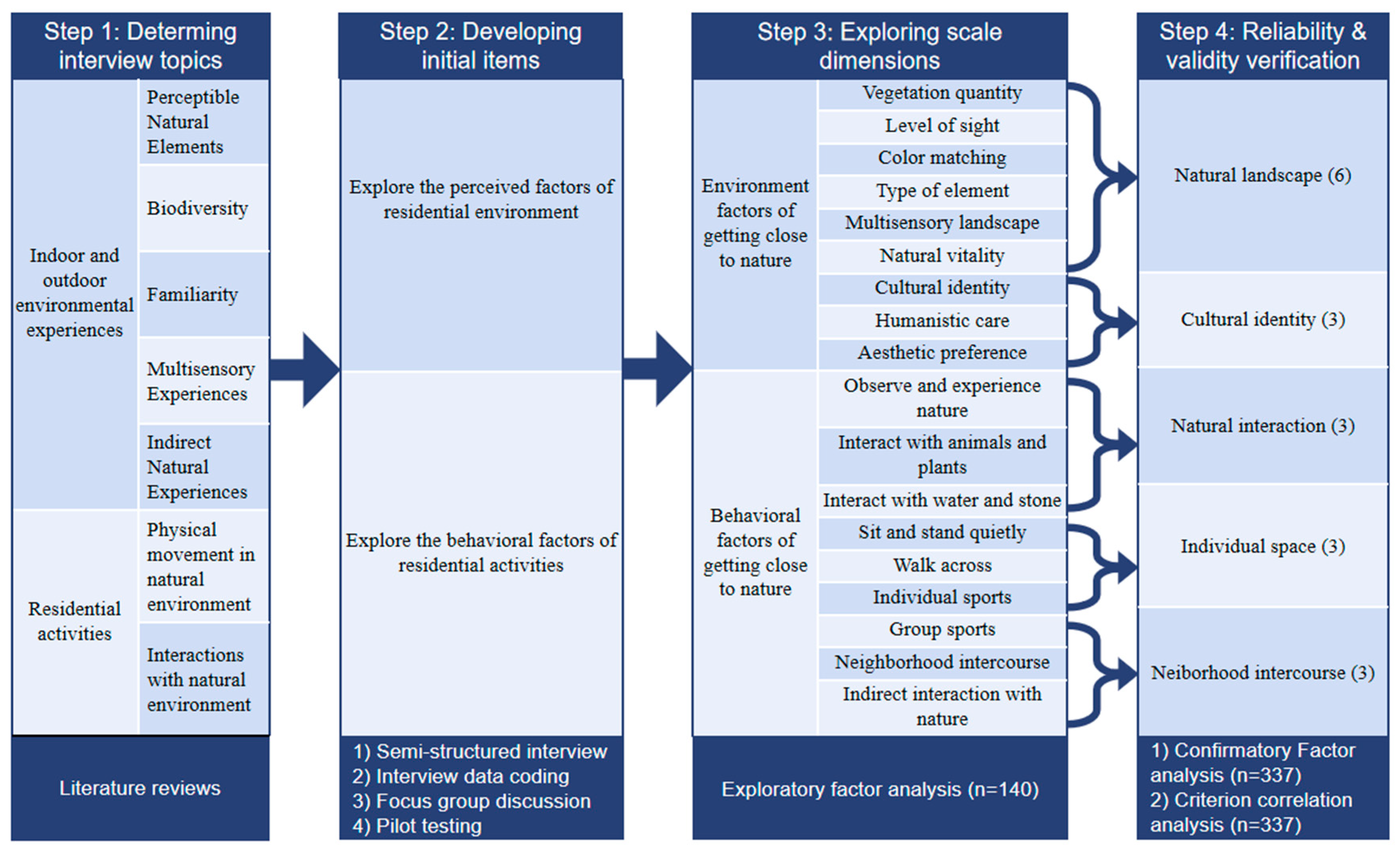
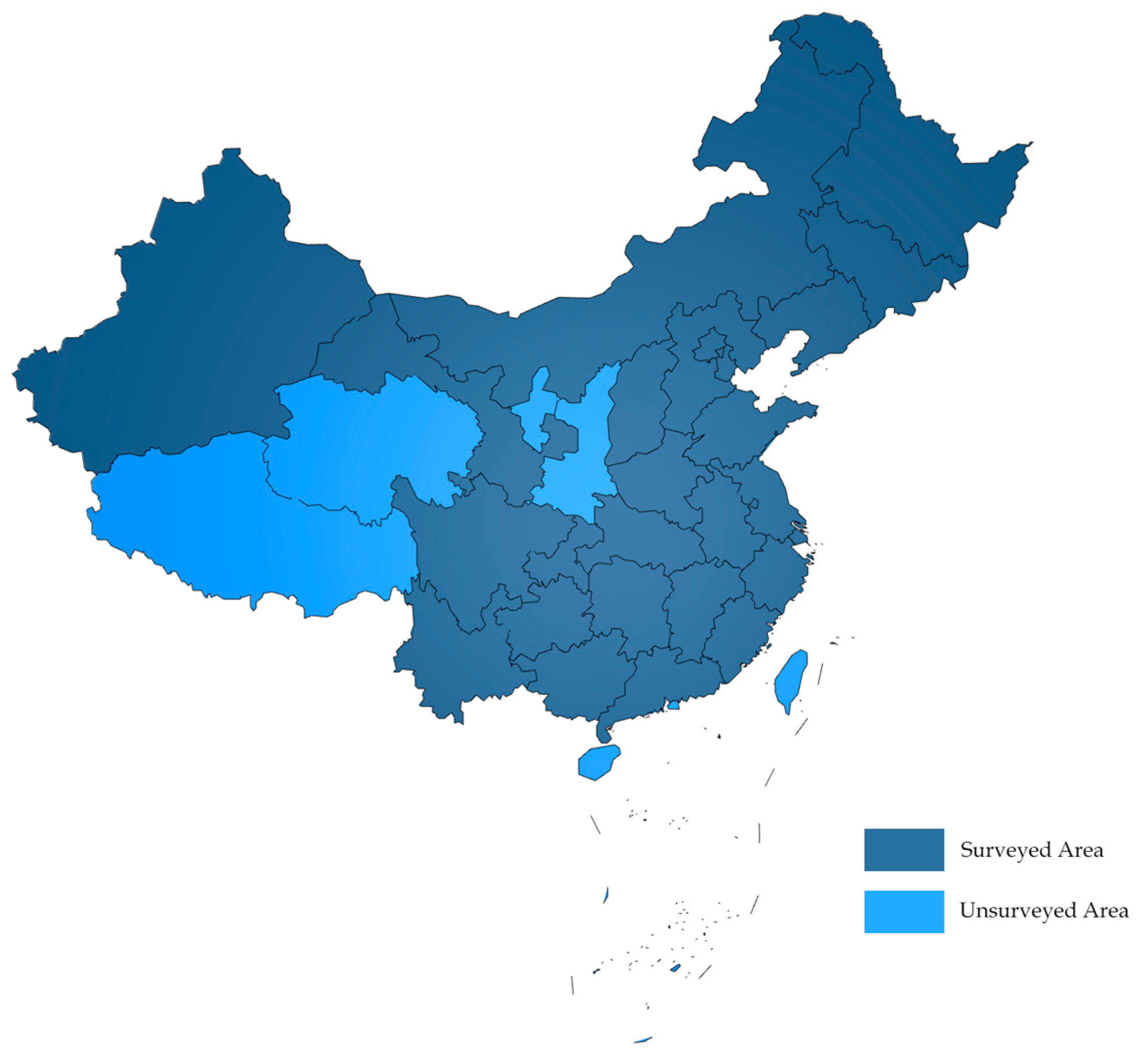

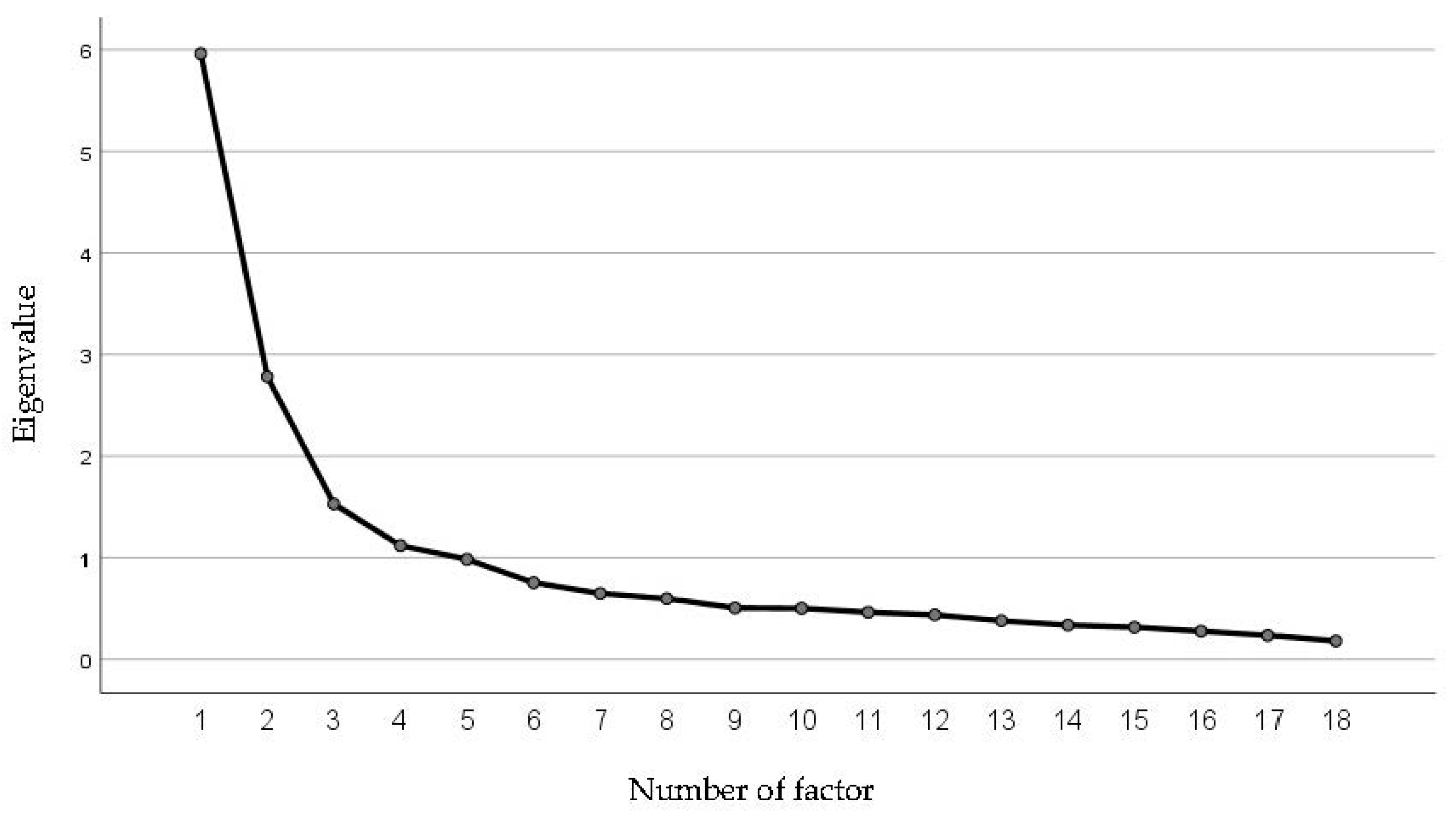
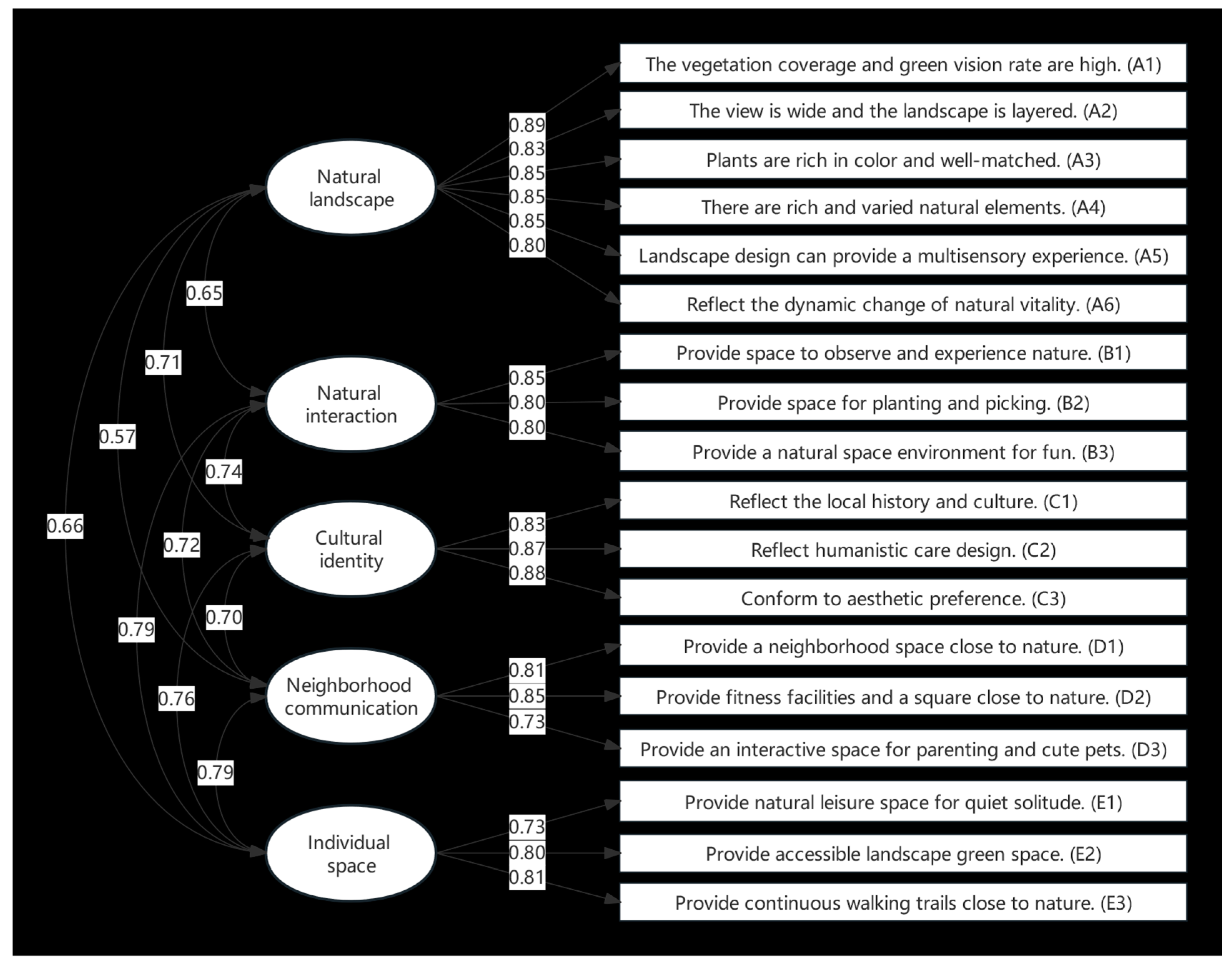
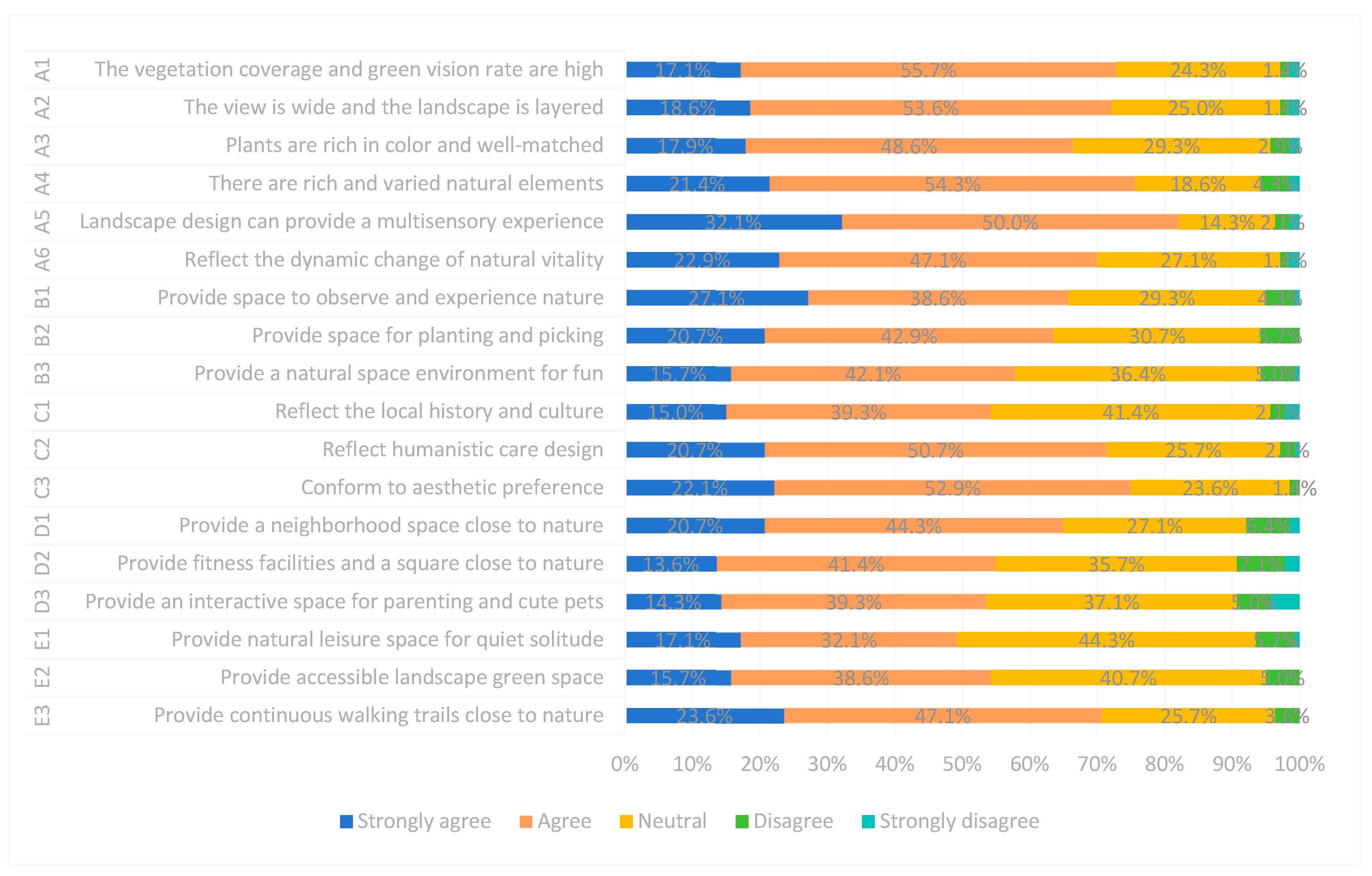
| Category | Factors | Examples |
|---|---|---|
| Indoor and outdoor environmental experiences | Perceptible Natural Elements | A large number of natural elements [30,31]; community gardens with frequent access [32]; prolonged opportunities for engagement [33], as well as easy accessibility [34] |
| Biodiversity | Neighborhood green spaces with high biodiversity and well-designed ecosystems [35]; rustic-style cottage gardens with wild plants [36]; thriving plants [37] | |
| Familiarity | Regularly encountering and feeling familiar with natural environments [38,39]; local attachment and social identity [40] | |
| Multisensory Experiences | Soundscapes [41]; sound of waterfalls and streams [38]; walking barefoot in nature [42] | |
| Indirect Natural Experiences | Window views of trees and parks adjacent to buildings [43]; wooden walls and floors [44]; biophilic design in residential interiors such as natural images, forms, colors, and materials [45] | |
| Residential activities | Physical movement in natural environment | Frequent visits to green space, water, and other landscapes by walking, running, and cycling [46]; physical exercise [47,48] |
| Interactions with natural environment | Natural environment for sitting, touching, and playing with [49]; urban gardening accompanied by nature observation, leisure, physical exercise, social interaction, and knowledge acquisition [50]; community gardening activities [37,51] |
| Classification | Problem | Subproblem |
|---|---|---|
| (1) Exploring elements of environmental perception | Which environmental elements can make you feel more connected to or closer to nature? | What are the characteristics of these environmental elements, and what makes them particularly impressive to you? |
| (2) Exploring elements of behavioral activity | What activities can you do at home or within your community to feel more connected to or closer to nature? | Why do these things bring about a sense of connection to nature, and what specific feelings do they evoke? |
| Measure | Items | Frequency (n = 140) | Percentage (n = 140) | Frequency (n = 337) | Percentage (n = 337) |
|---|---|---|---|---|---|
| Gender | Male | 73 | 52.1% | 157 | 46.6% |
| Female | 67 | 47.9% | 180 | 53.4% | |
| Age | 18~40 | 76 | 54.3% | 207 | 61.4% |
| 41~60 | 61 | 43.6% | 126 | 37.4% | |
| >60 | 3 | 2.1% | 4 | 1.2% | |
| Education Level | Graduate | 4 | 2.9% | 7 | 2.1% |
| Junior College or University | 76 | 54.3% | 250 | 74.2% | |
| Other | 60 | 42.8% | 80 | 23.7% |
| Category | Influencing Factors |
|---|---|
| Space Environment | Vegetation quantity (high vegetation coverage, high proportion of green plants in the field of view); |
| Visual hierarchy (wide field of view, layered with highs and lows); | |
| Color matching (rich plant colors, properly matched); | |
| Types of natural elements (including sunshine, plants, water features, animals, rocks and sand, gentle breezes, etc.); | |
| Multisensory experience (incorporating visual (landscape), tactile (texture), olfactory (floral scents, a refreshing air), auditory (quietness, bird chirping, water sound), etc.); | |
| Natural vitality (thriving and growing vigorously, displaying a variety of colors and forms); | |
| Historical and cultural heritage (reflecting the local history and culture, evoking a sense of familiarity and identification); | |
| Humanistic care (such as windproof and rainproof, design for the elderly and children, climate-adaptive design); | |
| Neat and tidy (clean and well-maintained). | |
| Behavioral Activity | Observing experiences (smelling flower fragrance, observing insects and animals, enjoying the scenery, sunbathing, sitting on the grass); |
| Interacting with animals and plants (planting, harvesting, caring for animals, catching fish and shrimp); | |
| Interacting with sand and stones (playing in the water, playing with sand, climbing rocks, exploring caves); | |
| Sitting or standing quietly (reading, drawing, using a phone); | |
| Crossing the greenway (commuting, traveling, shopping); | |
| Personal exercise (walking, running, cycling, rollerblading); | |
| Group exercises (playing ball, practicing Tai Chi, square dancing); | |
| Social activities (chatting, playing with friends, community events); | |
| Indirect interaction (taking care of children, walking dogs, watching birds); | |
| Facility usage (swinging on a swing, playing on a hammock, setting up a tent, using fitness equipment). |
| Factor | Code | Item | Factor Loading | Eigenvalue | Explanatory Variance/% | Cumulative Explanatory Variance/% | Cronbach’s α |
|---|---|---|---|---|---|---|---|
| Natural Landscape | A1 | The vegetation coverage and green vision rate were high. | 0.832 | 6.095 | 33.862 | 33.862 | 0.884 |
| A2 | The view is wide and the landscape is layered. | 0.699 | |||||
| A3 | Plants are rich in color and well-matched. | 0.817 | |||||
| A4 | Both sunshine, plants, water features, animals, sand, breeze, and other natural elements, rich and diverse. | 0.781 | |||||
| A5 | Landscape design can provide a multisensory experience with sight, hearing, smell, taste, and touch. | 0.840 | |||||
| A6 | Reflect the dynamic change of natural vitality. | 0.592 | |||||
| Nature Interaction | B1 | Provide space to observe and experience nature. | 0.793 | 2.765 | 15.361 | 49.223 | 0.763 |
| B2 | Provide space for natural interaction, such as planting and picking. | 0.806 | |||||
| B3 | Provide a natural space environment for fun. | 0.619 | |||||
| Cultural Identity | C1 | Reflect the local history and culture. | 0.738 | 1.527 | 8.484 | 57.707 | 0.738 |
| C2 | Reflect the humanistic care of shading the sun and rain, suitable for the old and young. | 0.601 | |||||
| C3 | Conform to aesthetic preference and maintain clean and tidy. | 0.662 | |||||
| Neighborhood Communication | D1 | Provide a neighborhood space close to nature. | 0.769 | 1.101 | 6.117 | 63.824 | 0.781 |
| D2 | Provide fitness facilities and a square close to nature. | 0.647 | |||||
| D3 | Provide an interactive space for parenting and cute pets close to nature. | 0.800 | |||||
| Individual Space | E1 | Provide natural leisure space for quiet solitude. | 0.731 | 0.983 | 5.459 | 69.283 | 0.746 |
| E2 | Provide accessible landscape green space. | 0.641 | |||||
| E3 | Provide continuous walking trails close to nature. | 0.615 |
| Fitting Index | Fitting Standard | Statistical Result |
|---|---|---|
| χ2 | The smaller, the better | 324.419 |
| Normed chi-square (χ2/df) | <3.000 | 2.595 |
| Goodness-of-Fit Index (GFI) | >0.900 | 0.908 |
| Root Mean Square Error of Approximation (RMSEA) | <0.080 | 0.069 |
| NFI a/CFI b/TLI c/IFI d | >0.900 | 0.931/0.956/0.946/0.956 |
| Factor | Code | Standard Factor Loading | Average Variance Extracted (AVE) | Composite Reliability (CR) |
|---|---|---|---|---|
| Natural Landscape | A1 | 0.891 | 0.715 | 0.938 |
| A2 | 0.831 | |||
| A3 | 0.846 | |||
| A4 | 0.854 | |||
| A5 | 0.853 | |||
| A6 | 0.796 | |||
| Nature Interaction | B1 | 0.853 | 0.669 | 0.858 |
| B2 | 0.802 | |||
| B3 | 0.797 | |||
| Cultural Identity | C1 | 0.834 | 0.742 | 0.896 |
| C2 | 0.873 | |||
| C3 | 0.876 | |||
| Neighborhood Communication | D1 | 0.806 | 0.633 | 0.837 |
| D2 | 0.847 | |||
| D3 | 0.729 | |||
| Individual Space | E1 | 0.734 | 0.613 | 0.826 |
| E2 | 0.799 | |||
| E3 | 0.813 |
| Natural Landscape | Nature Interaction | Cultural Identity | Neighborhood Communication | Individual Space | |
|---|---|---|---|---|---|
| Natural Landscape | 0.715 | ||||
| Nature Interaction | 0.652 | 0.669 | |||
| Cultural Identity | 0.710 | 0.744 | 0.742 | ||
| Neighborhood Communication | 0.571 | 0.717 | 0.701 | 0.633 | |
| Individual Space | 0.663 | 0.790 | 0.762 | 0.795 | 0.613 |
| Square root of AVE | 0.846 | 0.818 | 0.861 | 0.796 | 0.783 |
| Code | Mean | SD | NC | A1 | A2 | A3 | A4 | A5 | A6 | B1 | B2 | B3 | C1 | C2 | C3 | D1 | D2 | D3 | E1 | E2 | E3 |
|---|---|---|---|---|---|---|---|---|---|---|---|---|---|---|---|---|---|---|---|---|---|
| NC | 3.25 | 0.962 | 1 | ||||||||||||||||||
| A1 | 3.96 | 0.799 | 0.364 ** | 1 | |||||||||||||||||
| A2 | 3.94 | 0.818 | 0.338 ** | 0.748 ** | 1 | ||||||||||||||||
| A3 | 3.90 | 0.858 | 0.333 ** | 0.745 ** | 0.716 ** | 1 | |||||||||||||||
| A4 | 3.99 | 0.842 | 0.295 ** | 0.756 ** | 0.691 ** | 0.748 ** | 1 | ||||||||||||||
| A5 | 4.06 | 0.827 | 0.354 ** | 0.756 ** | 0.687 ** | 0.734 ** | 0.749 ** | 1 | |||||||||||||
| A6 | 3.94 | 0.856 | 0.354 ** | 0.732 ** | 0.663 ** | 0.637 ** | 0.656 ** | 0.677 ** | 1 | ||||||||||||
| B1 | 3.94 | 0.932 | 0.231 ** | 0.436 ** | 0.452 ** | 0.413 ** | 0.447 ** | 0.503 ** | 0.515 ** | 1 | |||||||||||
| B2 | 3.83 | 0.924 | 0.250 ** | 0.470 ** | 0.436 ** | 0.493 ** | 0.453 ** | 0.413 ** | 0.451 ** | 0.711 ** | 1 | ||||||||||
| B3 | 3.80 | 0.968 | 0.240 ** | 0.442 ** | 0.484 ** | 0.429 ** | 0.432 ** | 0.446 ** | 0.529 ** | 0.669 ** | 0.618 ** | 1 | |||||||||
| C1 | 3.84 | 0.913 | 0.265 ** | 0.521 ** | 0.565 ** | 0.438 ** | 0.489 ** | 0.450 ** | 0.499 ** | 0.537 ** | 0.448 ** | 0.548 ** | 1 | ||||||||
| C2 | 3.92 | 0.883 | 0.338 ** | 0.556 ** | 0.533 ** | 0.441 ** | 0.511 ** | 0.519 ** | 0.526 ** | 0.515 ** | 0.473 ** | 0.577 ** | 0.737 ** | 1 | |||||||
| C3 | 4.05 | 0.829 | 0.266 ** | 0.538 ** | 0.571 ** | 0.506 ** | 0.572 ** | 0.547 ** | 0.550 ** | 0.559 ** | 0.505 ** | 0.566 ** | 0.719 ** | 0.766 ** | 1 | ||||||
| D1 | 3.84 | 0.963 | 0.291 ** | 0.316 ** | 0.407 ** | 0.344 ** | 0.336 ** | 0.389 ** | 0.358 ** | 0.433 ** | 0.358 ** | 0.444 ** | 0.454 ** | 0.486 ** | 0.488 ** | 1 | |||||
| D2 | 3.65 | 0.989 | 0.260 ** | 0.372 ** | 0.441 ** | 0.423 ** | 0.403 ** | 0.432 ** | 0.437 ** | 0.503 ** | 0.461 ** | 0.522 ** | 0.513 ** | 0.507 ** | 0.498 ** | 0.707 ** | 1 | ||||
| D3 | 3.62 | 1.032 | 0.213 ** | 0.398 ** | 0.421 ** | 0.395 ** | 0.437 ** | 0.392 ** | 0.397 ** | 0.511 ** | 0.517 ** | 0.556 ** | 0.502 ** | 0.487 ** | 0.428 ** | 0.585 ** | 0.583 ** | 1 | |||
| E1 | 3.76 | 0.924 | 0.263 ** | 0.494 ** | 0.442 ** | 0.479 ** | 0.417 ** | 0.446 ** | 0.461 ** | 0.432 ** | 0.456 ** | 0.438 ** | 0.483 ** | 0.514 ** | 0.510 ** | 0.422 ** | 0.446 ** | 0.429 ** | 1 | ||
| E2 | 3.82 | 0.867 | 0.195 ** | 0.461 ** | 0.451 ** | 0.479 ** | 0.393 ** | 0.412 ** | 0.424 ** | 0.487 ** | 0.447 ** | 0.517 ** | 0.531 ** | 0.519 ** | 0.547 ** | 0.519 ** | 0.577 ** | 0.497 ** | 0.609 ** | 1 | |
| E3 | 3.97 | 0.860 | 0.225 ** | 0.470 ** | 0.442 ** | 0.456 ** | 0.390 ** | 0.420 ** | 0.455 ** | 0.618 ** | 0.590 ** | 0.529 ** | 0.487 ** | 0.495 ** | 0.553 ** | 0.505 ** | 0.552 ** | 0.478 ** | 0.595 ** | 0.636 ** | 1 |
Disclaimer/Publisher’s Note: The statements, opinions and data contained in all publications are solely those of the individual author(s) and contributor(s) and not of MDPI and/or the editor(s). MDPI and/or the editor(s) disclaim responsibility for any injury to people or property resulting from any ideas, methods, instructions or products referred to in the content. |
© 2024 by the authors. Licensee MDPI, Basel, Switzerland. This article is an open access article distributed under the terms and conditions of the Creative Commons Attribution (CC BY) license (https://creativecommons.org/licenses/by/4.0/).
Share and Cite
Yue, M.; Zhang, X.; Zhang, J. Biophilic Experience in High-Rise Residential Areas in China: Factor Structure and Validity of a Scale. Sustainability 2024, 16, 2866. https://doi.org/10.3390/su16072866
Yue M, Zhang X, Zhang J. Biophilic Experience in High-Rise Residential Areas in China: Factor Structure and Validity of a Scale. Sustainability. 2024; 16(7):2866. https://doi.org/10.3390/su16072866
Chicago/Turabian StyleYue, Miao, Xinshuo Zhang, and Junjie Zhang. 2024. "Biophilic Experience in High-Rise Residential Areas in China: Factor Structure and Validity of a Scale" Sustainability 16, no. 7: 2866. https://doi.org/10.3390/su16072866
APA StyleYue, M., Zhang, X., & Zhang, J. (2024). Biophilic Experience in High-Rise Residential Areas in China: Factor Structure and Validity of a Scale. Sustainability, 16(7), 2866. https://doi.org/10.3390/su16072866






